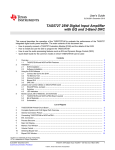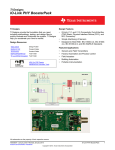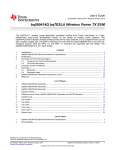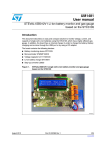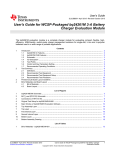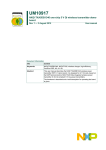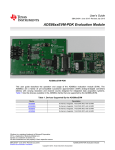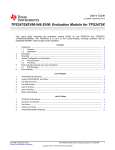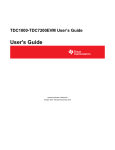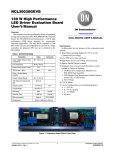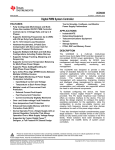Download bq500215 bqTESLA Wireless Power TX EVM
Transcript
User's Guide SLVUAB0A – October 2014 – Revised January 2015 bq500215 bqTESLA Wireless Power TX EVM The bqTESLA™ wireless power transmitter evaluation module from Texas Instruments is a highperformance, easy-to-use development module for the design of wireless power solutions. The bq500215 EVM evaluation module (EVM) provides all the basic functions of a Qi-compliant, wireless charger pad. The 12-V input, single coil transmitter enables designers to speed the development of their endapplications. The EVM supports both the WPC 1.0 and WPC 1.1 receivers and will support output power up to 5 W. The bq500215 EVM will operate with any Qi WPC 1.1 RX. When paired with the bq51025 RX EVM (bq51025EVM-649), receiver output power of up to 10 W is possible. 1 2 3 4 5 6 7 8 Contents Applications ................................................................................................................... 2 bq500215EVM-648 Electrical Performance Specifications............................................................. 2 Modifications.................................................................................................................. 3 Connector and Test Point Descriptions ................................................................................... 3 4.1 Input/Output Connections .......................................................................................... 3 4.2 Test Point Descriptions ............................................................................................ 4 Schematic and Bill of Materials ............................................................................................ 7 Test Setup ................................................................................................................... 12 6.1 Equipment .......................................................................................................... 12 6.2 Equipment Setup .................................................................................................. 13 bq500215EVM-648 Assembly Drawings and Layout .................................................................. 17 Reference ................................................................................................................... 20 List of Figures 1 bq500215EVM-648 Schematic, Page 1 of 3 ............................................................................. 7 2 bq500215EVM-648 Schematic, Page 2 of 3 ............................................................................. 8 3 bq500215EVM-648 Schematic, Page 3 of 3 ............................................................................. 9 4 Equipment Setup ........................................................................................................... 13 5 Efficiency versus Power, bq500215EVM-648 Transmitter and bq51025EVM-649 Receiver 6 Start Up ...................................................................................................................... 15 7 Thermal Performance ...................................................................................................... 16 8 Assembly Top ............................................................................................................... 17 9 Top Silk ...................................................................................................................... 18 10 Top Layer.................................................................................................................... 18 11 Inner Layer 1 ................................................................................................................ 19 12 Inner Layer 2 ................................................................................................................ 19 13 Bottom Layer ................................................................................................................ 20 .................... 14 List of Tables 1 bq500215EVM-648 Electrical Performance Specifications............................................................. 2 2 Bill of Materials ............................................................................................................. 10 bqTESLA is a trademark of Texas Instruments. Avid is a registered trademark of Avid Technology, Inc.. SLVUAB0A – October 2014 – Revised January 2015 Submit Documentation Feedback bq500215 bqTESLA Wireless Power TX EVM Copyright © 2014–2015, Texas Instruments Incorporated 1 Applications 1 www.ti.com Applications The bq500215EVM-648 evaluation module demonstrates the transmitter portion of the bqTESLA™ wireless power system. This transmitter EVM is a complete transmitter-side solution that powers a bqTESLA receiver. The EVM requires a single 12-V power supply capable of up to 2.0 A to operate and combines the transmitter electronics, input power circuit, LED indicators, and the transmitting coil on the single printed-circuit board (PCB). The open design allows easy access to key points of the electrical schematic. This EVM has the following features: • Proprietary 10 W charging capability with TI's bq51025 receiver • Qi-Certified WPC1.1 solution for 5-W operation • 12-V input and fixed operating frequency • Enhanced Foreign Object Detection (FOD) with FOD ping detecting objects prior to power transfer • WPC 1.1 FOD and WPC 1.0 Parasitic Metal Object Detection (PMOD) • Transmitter-coil mounting pad providing the correct receiver interface • Compact power section design using the CSD97374 NexFET power stage • Standard WPC A29-type transmitter coil with no magnet • LED and audio indication of power transfer 2 bq500215EVM-648 Electrical Performance Specifications Table 1 provides a summary of the EVM performance specifications. All specifications are given for an ambient temperature of 25°C. Table 1. bq500215EVM-648 Electrical Performance Specifications Parameter Notes and Conditions Min Typ Max Unit 11.50 12.0 12.5 V Input Characteristics VIN Input voltage IIN Input current VIN = Nom, IOUT = 1.4 A at 7 V 1.0 A Input no-load current VIN = Nom, IOUT = 0 A 90 mA Input stand-by current VIN = Nom 4 mA Output Characteristics – Receiver bq51025EVM-649 VOUT IOUT Output voltage VIN = Nom, IOUT = 1.4A , VOUT = 7 V Output ripple VIN = Nom, IOUT = 1.0 A, VOUT = 7 V VIN = Min to Max VIN = Min to Max, VOUT = 7 V 6.7 7.0 0 7.3 V 200 mVPP 1.4 A Systems Characteristics 2 FS Switching frequency During power transfer 130 kHz ηpk Peak efficiency VIN = Nom, P Out RX = 7.0 W 81 % η Full-load efficiency VIN = Nom, IOUT = Max 80 % bq500215 bqTESLA Wireless Power TX EVM SLVUAB0A – October 2014 – Revised January 2015 Submit Documentation Feedback Copyright © 2014–2015, Texas Instruments Incorporated Modifications www.ti.com 3 Modifications See the datasheet (SLUSBZ1) when changing components. Use LED Mode – Resistor R9 to change the behavior of the status LED, D5, D7, and D9. The standard value is 100 kΩ for control option 7, see the datasheet for additional settings. NTC – Connector JP3 provides the option for connecting a negative temperature coefficient (NTC) sensor for thermal protection, see the datasheet for additional settings. FOD – R8 threshold and R49 FOD_Cal (see Section 6.2.2.7) FOD_Ping – R47 and R48 (see Section 6.2.2.7) PMOD – R16 threshold and disable (see Section 6.2.2.7) 4 Connector and Test Point Descriptions 4.1 Input/Output Connections The connection points are described in Section 4.1.1 through Section 4.1.5. 4.1.1 J1 – VIN Input power 12 V ±500 mV, return at J2. 4.1.2 J2 – GND Return for input power, input at J1. 4.1.3 J3 –JTAG Factory use only. 4.1.4 J4 – Serial Interface 2 I C interface connection to communicate with the IC. Used with bqTESLA TX Tuning Tool to monitor behavior. 4.1.5 JP1 – FOD / PMOD Enable Shorting jumper must be installed to enable FOD and PMOD functions. See the datasheet for additional details. 4.1.6 JP2 – LED Mode External connection for LED MODE resistor, if R9 is removed. When shorted, IC will disable LED and inhibit low power mode, useful for troubleshooting 4.1.7 JP3 – NTC The connection point for the external temperature sensor. See the datasheet for more information. SLVUAB0A – October 2014 – Revised January 2015 Submit Documentation Feedback bq500215 bqTESLA Wireless Power TX EVM Copyright © 2014–2015, Texas Instruments Incorporated 3 Connector and Test Point Descriptions 4.2 www.ti.com Test Point Descriptions The test points are described in Section 4.2.1 through Section 4.2.32. 4.2.1 TP1 – FP_RES FOD ping circuit setting, see data sheet for more information. 4.2.2 TP2 – Drive A Output from Power Section A of H-Bridge, U2. 4.2.3 TP3 – Coil Monitor L / C Coil signal at junction between transmitter coil and resonant capacitors. 4.2.4 TP4 -– Low Noise Analog Ground Low noise ground test point (TP) 4.2.5 TP5 -– Low Noise Analog Ground Low noise ground TP 4.2.6 TP6 -– Unused IC Pin 27 Low noise ground TP 4.2.7 TP7 – Demodulation Comm + Output Primary communications channel, input to bq500215, U1 from demodulation circuit. 4.2.8 TP8 -– I_Sense Input current-sense voltage, scale 1 V = 1 A. 4.2.9 TP9 – RAIL+ Sample voltage from rail converter output, input to bq500215 rail control ckt . 4.2.10 TP10 – Unused IC Pin 29 Unused pin. 4.2.11 TP11 – Unused IC Pin 57 Unused pin. 4.2.12 TP12 – Low Noise Analog Ground Low noise ground TP 4.2.13 TP13 – Unused IC Pin 56 Unused pin. 4.2.14 TP14 – FP_DECAY FOD ping circuit setting, see data sheet for more information. 4 bq500215 bqTESLA Wireless Power TX EVM SLVUAB0A – October 2014 – Revised January 2015 Submit Documentation Feedback Copyright © 2014–2015, Texas Instruments Incorporated Connector and Test Point Descriptions www.ti.com 4.2.15 TP15 – Drive B Output from Power Section B of H-Bridge, U3. 4.2.16 TP16 – FOD_Cal FOD calibration resistor test point, connected to pin 22 of bq500215. 4.2.17 TP17 – Low Noise Analog Ground Low noise ground TP 4.2.18 TP18 – Rail Output Voltage Output voltage from rail buck converter that feeds H-Bridge Power Section. 4.2.19 TP19 – PWM_RAIL Digital input to rail converter Power Section from bq500215. Signal is PWM, used to control rail voltage. 4.2.20 TP20 – DPWM-A Signal Digital output signal from bq500215 to H-Bridge drive for U2. 4.2.21 TP21 – DPWM-B Signal Digital output signal from bq500215 to H-Bridge drive for U3. 4.2.22 TP22 – BUZ_DC DC output when power transfer is started. Can be used to drive a DC style buzzer or LED. See data sheet for more information. 4.2.23 TP23 – Unused IC Pin 28 Unused pin. 4.2.24 TP24 – Unused IC Pin 6 Unused pin. 4.2.25 TP25 – Unused IC Pin 5 Unused pin. 4.2.26 TP26 – Unused IC Pin 4 Unused pin. 4.2.27 TP27 – Unused IC Pin 34 Unused pin. 4.2.28 TP28 – Unused IC Pin 35 Unused pin. 4.2.29 TP29 – Unused IC Pin 41 Unused pin. SLVUAB0A – October 2014 – Revised January 2015 Submit Documentation Feedback bq500215 bqTESLA Wireless Power TX EVM Copyright © 2014–2015, Texas Instruments Incorporated 5 Connector and Test Point Descriptions 4.2.30 www.ti.com TP30 – Unused IC Pin 42 Unused pin. 4.2.31 TP31 – V33FB Reserved, leave this pin open. 4.2.32 TP32 – Unused IC Pin 33 Unused pin. 6 bq500215 bqTESLA Wireless Power TX EVM SLVUAB0A – October 2014 – Revised January 2015 Submit Documentation Feedback Copyright © 2014–2015, Texas Instruments Incorporated Schematic and Bill of Materials www.ti.com 5 Schematic and Bill of Materials This section includes the schematics and bill of materials for the EVM. Figure 1 through Figure 3 illustrate the schematics for this EVM. 3V3 C34 1µF 0.1µF C21 C3 4.7µF C5 4.7µF C36 1µF 1µF 47 C20 1µF 58 TP31 PWR_UP 3V3 COMM+ R23 10.0k COMM- 62 50 51 52 53 C38 V-Rail 0.1µF RAIL+ JP3 RAIL- R10 76.8k 54 55 2 63 R11 C4 10.0k 4700pF SNOOZE_CAP PM_CLK LED PM_DATA LED-A LED-B R25 10.0k 3 15 16 61 3V3 JP2 R9 42.2k LOSS_THR I_SENSE 60 59 9 LED-C C22 R15 475 R32 475 R31 475 0.1µF FP_RES FP_DECAY PEAK_DET D6 Green D7 Super Red D8 Yellow TDO TMS /TRST TDI TCK RET_CLK LOSS_THR U4 7 45 46 44 19 20 1 37 39 40 38 36 10 V33DIO V33D V33A V33DIO PWM-A PWM-B PWM_RAIL BPCAP FOD_CAL V33FB FOD PWR_UP PMOD COMM_A+ LED-A COMM_ALED-B COMM_B+ LED-C COMM_BBUZZ-AC V_RAIL+ BUZ-DC V_RAILSNOOZE T_SENSE SNOOZE_CHG 17 18 21 DPWM-A LOSS R27 PWM_RAIL TP16 22 R49 DNP 24 13 25 LED-A TP1 FP_RES 56.2k R16 100k R47 86.6k TP14 LED-B FP_DECAY 14 30 R48 86.6k 1 2 LS1 JTAG For Development Only Remove Pin 6 for Polarity LED-C J3 31 32 3V3 DNP R8 23 12 JP1 DPWM-B 9 8 7 6 5 4 3 2 1 R46 22 C7 DNP R45 TP22 14 12 10 8 6 4 2 PS1240P02CT3 10.0k SNOOZE SNOOZE_CHG DNP 13 11 9 7 5 3 1 TCK RET_CLK TDO TDI TMS V_SENSE SNOOZE_CAP SLEEP CLK DATA LED_MODE LOSS_THR I_SENSE RESET FP_RES Unused Unused Unused Unused Unused Unused Unused Unused Unused Unused Unused Unused Unused 11 41 27 28 4 5 6 33 29 56 57 34 35 42 FP_DECAY PEAK_DET Reserved Reserved Reserved Reserved Reserved Reserved DGND DGND DGND AGND2 AGND AGND3 EPAD SLEEP TP29 TP6 TP23 TP26 TP25 TP24 TP32 TP10 TP13 TP11 TP28 TP30 /TRST 3V3 R43 10.0k PMBus J4 3V3 R52 R51 10.0k 10.0k R53 DNP PM_DATA TP27 2 4 6 8 10 1 3 5 7 9 PM_CLK R54 10.0k 43 26 8 48 49 64 65 BQ500215RGC STATUS Figure 1. bq500215EVM-648 Schematic, Page 1 of 3 SLVUAB0A – October 2014 – Revised January 2015 Submit Documentation Feedback bq500215 bqTESLA Wireless Power TX EVM Copyright © 2014–2015, Texas Instruments Incorporated 7 Schematic and Bill of Materials www.ti.com VIN C27 10µF U1 VGATE 2 VDD C1 BOOT VIN 7 5 1µF WE-PD Type 1 SKIP# BOOT_R VSW 6 C12 0.1µF DNP DNP 8 PWM PGND PAD V-Rail R28 10uH TP19 PWM_RAIL TP18 L2 4 C8 47µF 3 9 R44 0.02 DNP 2 CSD97374Q4M R7 10.0 GND R2 130k R17 10.0 5 U7 INA199A1DCK C29 0.1µF C43 DNP C31 C42 DNP 47µF U3 47µF C15 0.1µF 5 7 5 BOOT_R 2 3 DPWM-A C35 1 R13 TP2 6 8 PWM PGND PAD L3 TP3 TP15 4 C10 0.1µF C19 0.1µF C16 0.047µF 6 4 760308141 TP20 3V3 DNP 6 7 BOOT VGATE VDD 2 C13 VIN 1µF SKIP# VSW 10.0 C45 R3 10.0k DNP RAIL- VIN 1 4 RAIL+ BOOT 1µF 1µF R12 VDD C9 C46 TP9 DNP C24 U2 VGATE C44 4700pF CSD97374Q4M 3 9 10.0 1 VSW PGND PAD PWM 8 DNP DPWM-B CSD97374Q4M C11 DNP 0.01µF SKIP# TP21 C18 3 9 BOOT_R 3V3 R22 1.00k D3 DNP TP8 I_SENSE R20 PEAK_DET R6 200k BAT54SWT1G TP7 10.0 C48 0.1µF C37 R18 1.00Meg DNP COMM+ C49 0.1µF R14 23.2k R29 D10 BAT54SWT1G 10.0 330pF R5 10.0k C14 33pF R19 COMM- 10.0 Figure 2. bq500215EVM-648 Schematic, Page 2 of 3 8 bq500215 bqTESLA Wireless Power TX EVM SLVUAB0A – October 2014 – Revised January 2015 Submit Documentation Feedback Copyright © 2014–2015, Texas Instruments Incorporated Schematic and Bill of Materials www.ti.com VIN WE-TPC Type 2 1 2 VIN 3 12 Vin DNP D4 C6 10µF 4 6 C25 0.1µF VIN PH EN BOOT VSENSE 8 300µH 1 5 C26 0.1µF SS COMP GND 7 C30 0.1µF R42 475 TPS54231D C32 NT1 1 2 C2 47µF 0.01µF TP4 TP5 TP12 TP17 J2 R37 76.8k D1 MBR0540T1G R1 10.0k GND C28 3V3 L1 U5 J1 R4 3.16k 2700pF Net-Tie D2 Green VGATE NT2 D11 BAT54SWT1G Net-Tie VIN R36 523k R40 300 VGATE R21 PWR_UP U6 TLV70450DBVT 3 R50 0 R38 2.00Meg D9 BAT54SWT1G 5 R34 499k Q1 IN NC NC C47 GND 1µF 1 C23 1µF OUT 1.00Meg C17 2 R41 1.00Meg 2.2µF 4 C33 R26 SNOOZE_CHG 0.1µF 475 R35 D5 BAT54SWT1G 4.99k Q3 BSS138 Q2 BSS138 C41 100µF R30 523k C40 4.7µF R39 R33 10.0k 10.0k SLEEP SNOOZE R24 523k SNOOZE_CAP C39 4.7µF Figure 3. bq500215EVM-648 Schematic, Page 3 of 3 SLVUAB0A – October 2014 – Revised January 2015 Submit Documentation Feedback bq500215 bqTESLA Wireless Power TX EVM Copyright © 2014–2015, Texas Instruments Incorporated 9 Schematic and Bill of Materials www.ti.com Table 2 contains the BOM for this EVM. Table 2. Bill of Materials (1) Designator Qty Value Description Package Reference Part Number Manufacturer C1, C9, C13, C20, C21, C34, C36, C47 8 1uF CAP, CERM, 1uF, 16V, +/-10%, X7R, 0603 0603 GRM188R71C105KA12D MuRata C2 1 47uF CAP, CERM, 47uF, 6.3V, +/-10%, X5R, 1206 1206 GRM31CR60J476KE19L MuRata C3, C5, C39, C40 4 4.7uF CAP, CERM, 4.7uF, 10V, +/-10%, X5R, 0603 0603 CGB3B1X5R1A475K055AC TDK C4, C18 2 4700pF CAP, CERM, 4700pF, 50V, +/-10%, X7R, 0603 0603 GRM188R71H472KA01D MuRata C6, C27 2 10uF CAP, CERM, 10uF, 35V, +/-10%, X7R, 1210 1210 GRM32ER7YA106KA12L MuRata C7, C12, C15, C22, C25, C26, C29, C30, C33, C38, C48, C49 12 0.1uF CAP, CERM, 0.1uF, 50V, +/-10%, X7R, 0603 0603 GRM188R71H104KA93D MuRata C8 1 47uF CAP, TA, 47uF, 16V, +/-20%, 0.6 ohm, SMD 3528 F951C476MBAAQ2 AVX C10, C19 2 0.1uF CAP, CERM, 0.1uF, 100V, +/-5%, C0G/NP0, 1812 1812 C1812C104J1GACTU Kemet C14 1 33pF CAP, CERM, 33pF, 50V, +/-5%, C0G/NP0, 0603 0603 GRM1885C1H330JA01D MuRata C16 1 0.047uF CAP, CERM, 0.047uF, 100V, +/-5%, C0G/NP0, 1812 1812 C4532C0G2A473J200KA TDK C17 1 2.2uF CAP, CERM, 2.2uF, 25V, +/-10%, X5R, 1206 1206 GRM316R61E225KA12D MuRata C23, C46 2 1uF CAP, CERM, 1uF, 16V, +/-10%, X7R, 0603 0603 C1608X7R1C105K TDK C24, C31 2 47uF CAP, CERM, 47uF, 25V, +/-20%, X5R, 1206 1206 C3216X5R1E476M160AC TDK C28, C35 2 0.01uF CAP, CERM, 0.01uF, 50V, +/-10%, X7R, 0603 0603 GRM188R71H103KA01D MuRata C32 1 2700pF CAP, CERM, 2700pF, 50V, +/-5%, C0G/NP0, 0603 0603 GRM1885C1H272JA01D MuRata C37 1 330pF CAP, CERM, 330pF, 50V, +/-5%, C0G/NP0, 0603 0603 GRM1885C1H331JA01D MuRata C41 1 100uF CAP, CERM, 100uF, 6.3V, +/-20%, X5R, 1206 1206 GRM31CR60J107ME39L MuRata D1 1 40V, 0.5A Diode, Schottky, 40V, 0.5A, SOD-123 SOD-123 MBR0540T1G ON Semiconductor D2, D6 2 Green LED, Green, SMD LED_0603 150060VS75000 Wurth Elektronik eiSos D3, D5, D9, D10, D11 5 30V Diode, Schottky, 30V, 0.2A, SOT-323 SOT-323 BAT54SWT1G Fairchild Semiconductor D7 1 Super Red LED, Super Red, SMD LED_0603 150060SS75000 Wurth Elektronik eiSos D8 1 Yellow LED, Yellow, SMD LED_0603 150060YS75000 Wurth Elektronik eiSos L1 1 300uH Inductor, Shielded, 300uH, 0.13A, 4.1 ohm, SMD 4.8x1.8x4.8mm 744042331 Wurth Elektronik eiSos L2 1 10uH Inductor, Shielded Drum Core, Ferrite, 10uH, 2.6A, 0.0515 ohm, SMD 10x3x10mm 7447713100 Wurth Elektronik eiSos L3 1 10uH Inductor, Wirewound, 10uH, 9A, 0.028 ohm, TH 54.4x6.5x54.4mm 760308141 Wurth Elektronik eiSos LS1 1 Buzzer, Piezo, 4kHz, 12.2mm, TH 12.2x4.0mm PS1240P02CT3 TDK Q1 1 DTC114Y UA Transistor, Digital NPN, 50 V, 100 mA SC-70 DTC114YUAT-106 Rohm Q2, Q3 2 50V MOSFET, N-CH, 50V, 0.22A, SOT-23 SOT-23 BSS138 Fairchild Semiconductor R1, R3, R5, R11, R23, R25, R33, R39, R43, R45, R51, R52 12 10.0k RES, 10.0k ohm, 1%, 0.1W, 0603 0603 CRCW060310K0FKEA Vishay-Dale R2 1 130k RES, 130k ohm, 1%, 0.1W, 0603 0603 CRCW0603130KFKEA Vishay-Dale R4 1 3.16k RES, 3.16k ohm, 1%, 0.1W, 0603 0603 CRCW06033K16FKEA Vishay-Dale R6 1 200k RES, 200k ohm, 1%, 0.1W, 0603 0603 CRCW0603200KFKEA Vishay-Dale R35 1 4.99k RES, 4.99k ohm, 1%, 0.1W, 0603 0603 CRCW06034K99FKEA Vishay-Dale R8 1 56.2k RES, 56.2 k, 1%, 0.1 W, 0603 0603 CRCW060356K2FKEA Vishay-Dale (1) 10 Unless otherwise noted in the Alternate PartNumber and/or Alternate Manufacturer columns, all parts may be substituted with equivalents. bq500215 bqTESLA Wireless Power TX EVM SLVUAB0A – October 2014 – Revised January 2015 Submit Documentation Feedback Copyright © 2014–2015, Texas Instruments Incorporated Schematic and Bill of Materials www.ti.com Table 2. Bill of Materials (1) (continued) Designator Qty Value Description Package Reference Part Number Manufacturer R9, R16 2 100k RES, 100k ohm, 1%, 0.1W, 0603 0603 CRCW0603100KFKEA Vishay-Dale R10, R37 2 76.8k RES, 76.8k ohm, 1%, 0.1W, 0603 0603 CRCW060376K8FKEA Vishay-Dale R7, R17, R12, R13, R19, R20, R29 7 10.0 RES, 10.0 ohm, 1%, 0.1W, 0603 0603 CRCW060310R0FKEA Vishay-Dale R14 1 23.2k RES, 23.2k ohm, 1%, 0.1W, 0603 0603 CRCW060323K2FKEA Vishay-Dale R15, R26, R31, R32, R42 5 475 RES, 475 ohm, 1%, 0.1W, 0603 0603 CRCW0603475RFKEA Vishay-Dale R18, R21, R41 3 1.00Meg RES, 1.00Meg ohm, 1%, 0.1W, 0603 0603 CRCW06031M00FKEA Vishay-Dale R22 1 1.00k RES, 1.00k ohm, 1%, 0.1W, 0603 0603 CRCW06031K00FKEA Vishay-Dale R24, R30, R36 3 523k RES, 523k ohm, 1%, 0.1W, 0603 0603 CRCW0603523KFKEA Vishay-Dale R28 1 0.02 RES, 0.02 ohm, 0.5%, 0.5W, 1206 1206 LVK12R020DER Ohmite R34 1 499k RES, 499k ohm, 1%, 0.1W, 0603 0603 CRCW06034993KFKEA Vishay-Dale R38 1 2.00Meg RES, 2.00Meg ohm, 1%, 0.1W, 0603 0603 CRCW06032M00FKEA Vishay-Dale R40 1 300 RES, 300 ohm, 5%, 0.1W, 0603 0603 CRCW0603300RJNEA Vishay-Dale R46 1 22 RES, 22 ohm, 0.5%, 0.1W, 0805 0805 RR1220Q-220-D Susumu Co Ltd R47, R48 2 86.6k RES, 86.6 k, 1%, 0.1 W, 0603 0603 CRCW060386K6FKEA Vishay-Dale R49 0 Open Open 0603 Open R50 1 0 RES, 0 ohm, 5%, 0.1W, 0603 0603 CRCW06030000Z0EA Vishay-Dale R53 0 Open Res, 10.0k ohm, 1%, 0.1W, 0603 0603 CRCW060310K0FKEA Vishay-Dale R54 1 10.0k Res, 10.0k ohm, 1%, 0.1W, 0603 0603 CRCW060310K0FKEA Vishay-Dale U1, U2, U3 3 Synchronous Buck NexFET Power Stage, DPC0008A DPC0008A CSD97374Q4M Texas Instruments U4 1 10-W WPC v1.1 Compliant Wireless Power Controller, RGC0064B RGC0064B BQ500215RGC Texas Instruments U5 1 Buck Step Down Regulator with 3.5 to 28 V Input and 0.8 to 25 V Output, -40 to 150 degC, 8-Pin SOIC (D), Green (RoHS & no Sb/Br) D0008A TPS54231D Texas Instruments U6 1 Single Output LDO, 150 mA, Fixed 5 V Output, 2.5 to 24 V Input, with Ultra-Low IQ, 5pin SOT-23 (DBV), -40 to 125 degC, Green (RoHS & no Sb/Br) DBV0005A TLV70450DBVT Texas Instruments U7 1 Voltage Output, High or Low Side Measurement, Bi-Directional Zerø-Drift Series CurrentShunt Monitor, DCK0006A DCK0006A INA199A1DCK Texas Instruments C11 0 0.047uF CAP, CERM, 0.047uF, 100V, +/-5%, C0G/NP0, 1812 1812 C4532C0G2A473J200KA TDK C42, C43, C44 0 47uF CAP, CERM, 47uF, 25V, +/-20%, X5R, 1206 1206 C3216X5R1E476M160AC TDK C45 0 0.01uF CAP, CERM, 0.01uF, 50V, +/-10%, X7R, 0603 0603 GRM188R71H103KA01D MuRata D4 0 NoPop Diode, Schottky, 40V, 0.5A, SOD-123 SOD-123 MBR0540T1G ON Semiconductor R27 0 10k RES, 10k ohm, 2%, 0.2W, TH 9x1 ResNetwork 4309R-101-103LF Bourns R44 0 0.51 RES, 0.51 ohm, 1%, 0.25W, 0805 0805 CRM0805-FX-R510ELF Bourns SLVUAB0A – October 2014 – Revised January 2015 Submit Documentation Feedback bq500215 bqTESLA Wireless Power TX EVM Copyright © 2014–2015, Texas Instruments Incorporated 11 Test Setup 6 Test Setup 6.1 Equipment 6.1.1 www.ti.com bqTESLA™ Receiver Use the bq51025EVM-649, 10-W EVM. If a low power Qi-compliant receiver such as bq51020EVM-520 or bq51013BEVM-764 is used, then the maximum output power will be 5 W. Note that the following test setup only discusses the bq51025EVM-649 configuration. 6.1.2 Voltage Source The input voltage source must provide a regulated DC voltage of 12 V and deliver at least 2.0-A continuous load current; current limit must be set to 3 A. CAUTION To help assure safety integrity of the system and minimize risk of electrical shock hazard, always use a power supply providing suitable isolation and supplemental insulation (double insulated). Compliance to IEC 61010-1, Safety Requirements for Electrical Equipment for Measurement, Control and Laboratory Use, Part 1, General Requirements, or its equivalent is strongly suggested, including any required regional regulatory compliance certification approvals. Always select a power source that is suitably rated for use with this EVM as referenced in this user manual. External Power Supply Requirements: Nom Voltage:12.0 VDC Max Current: 3.0 A Efficiency Level V External Power Supply Regulatory Compliance Certifications: Recommend selection and use of an external power supply which meets TI’s required minimum electrical ratings in addition to complying with applicable regional product regulatory/safety certification requirements such as (by example) UL, CSA, VDE, CCC, PSE, and so forth. 6.1.3 Meters Monitor the output voltage at the bq51025EVM-649 test point TP7 with a voltmeter. Monitor the input current into the load with an appropriate ammeter. You can also monitor the transmitter input current and voltage, but the meter must use the averaging function for reducing error, due to communications packets. 6.1.4 Loads A single load is required at 7 V with a maximum current of 1.4 A. The load can be resistive or electronic. 6.1.5 Oscilloscope Use a dual-channel oscilloscope with appropriate probes to observe the RECT signal at bq51025EVM-649 TP3 and other signals. 6.1.6 Recommended Wire Gauge For proper operation, use 22-AWG wire when connecting the EVM to the input supply and the bq51025EVM-649 to the load. 12 bq500215 bqTESLA Wireless Power TX EVM SLVUAB0A – October 2014 – Revised January 2015 Submit Documentation Feedback Copyright © 2014–2015, Texas Instruments Incorporated Test Setup www.ti.com 6.2 Equipment Setup • • • 6.2.1 With the power supply OFF, connect the supply to the bqTESLA transmitter. Connect the VIN positive power source to J1, and connect the negative terminal of the VIN source to J2. Do not place the bqTESLA receiver on the transmitter. Connect a load to J3 with a return to J4, monitor current through the load with the ammeter, and monitor the voltage to the load at J3. All voltmeters must be Kelvin connected (at the pin) to the point of interest. Equipment Setup Diagram The diagram in Figure 4 shows the test setup. Figure 4. Equipment Setup 6.2.2 EVM Procedures This section provides guidance for a few general test procedures to exercise the functionality of the presented hardware. Some key notes follow: 6.2.2.1 Start-Up No Receiver Turn on VIN, and observe that the green power LED, D2, will flash. Status LEDs D6, D7, and D8 are OFF until the power transfer starts. Apply the scope probe to the test point, TP15, and observe single-pulse bursts approximately every 500 ms. This is a digital ping to begin communications with a receiver placed on the TX coil. 6.2.2.2 Apply Receivers Place the bq51025EVM-649 EVM on the top of the transmitting coil. Align the centers of the receiving and transmitting coils across each other. In the next few seconds, observe that the status LED, D5, flashes green, indicating that communication between the transmitter and the receiver is established and that power transfer has started. • The status LED, D6, flashes a green light during power transfer. • Typical output voltage is 7 V, and the output current range is 0 mA to 1.4 A. • Observe a continuous sine-wave on the test point TP15 when power transfer is active; the frequency is 130 kHz. • Make tests and measurements applicable to a normal 7-V power supply. SLVUAB0A – October 2014 – Revised January 2015 Submit Documentation Feedback bq500215 bqTESLA Wireless Power TX EVM Copyright © 2014–2015, Texas Instruments Incorporated 13 Test Setup 6.2.2.3 www.ti.com Efficiency Measure the system efficiency by measuring the output voltage, output current, input voltage, and input current and calculate efficiency as the ratio of the output power to the input power. Connect voltage meters at the input and output of TX and RX (see Figure 4). Average the input current; the comm pulses modulate the input current, distorting the reading. Figure 5 shows efficiency. Figure 5. Efficiency versus Power, bq500215EVM-648 Transmitter and bq51025EVM-649 Receiver 6.2.2.4 LED Behavior D2 – Green power on LED driven by 3.3-V DC-to-DC converter. During STANDBY (no RX) flash at half second rate. During power transfer ON, also ON during fault condition. D6 – Green status driven by bq500215 (LED-A). Blink during power transfer, slow blink for 5 W (Qi) about once a second and fast blink for 10 W (bq50025 RX) about twice a second. D7 – Red status driven by bq500215 (LED-B). When the receiver sends Charge Complete (EPT01) LED is ON for about 5 seconds then off. D8 – Yellow status driven by bq500215 (LED-C). On during fault condition and blinks during FOD warning. NOTE: Status LED behavior is controlled by LED mode resistor R9, 100 kΩ for mode 7. See the data sheet for additional options and configurations of LED D6, D7, and D8. 14 bq500215 bqTESLA Wireless Power TX EVM SLVUAB0A – October 2014 – Revised January 2015 Submit Documentation Feedback Copyright © 2014–2015, Texas Instruments Incorporated Test Setup www.ti.com 6.2.2.5 Start Up Receiver Placed on Transmitter The Transmitter will send a digital ping about every 500 ms. If a receiver is present it will power up and reply then begin power transfer. Below is a scope capture of the bq500215 EVM beginning a power transfer with bq51025 EVM. Figure 6. Start Up 6.2.2.6 Thermal Protection, NTC Thermal protection is provided by an NTC resistor connected to JP3. At 1 V on the sense side (U1-2), the thermal fault is set, and the unit is shut down, The status LED, D8, illuminates orange. The typical resistor value for fault is 850 Ω. The system tries to restart in 5 minutes. 6.2.2.7 Foreign Object Detection (FOD) / Parasitic Metal Object Detection (PMOD) The bq500215 EVM supports multiple levels of protection against eating metal objects placed in the magnetic field during power transfer. PMOD is used for older WPC 1.0 version receivers and FOD is used for WPC 1.1 or greater. The first level is a short FOD ping that detects most objects before any power transfer is initiated, analysis of the impulse response is used. Resistors R47 and R48 are used to tune this function, see data sheet for additional information. The second level is power loss accounting, a comparison between power transmitted to the receiver (RX) with the power the RX reported receiving, difference is loss power possibly going into a foreign object. The transmitter determines the power sent to the RX by measuring input power and calculating internal losses. The RX measures the power it received and also calculates losses. The RX sends this information to the driver (TX) in a digital word, message packet. Unaccounted for power loss is presumed to be a foreign object on the charging pad. Should this lost power exceed the threshold set by R8, a FOD fault is set and power transfer is stopped. Three key measurements for the TX FOD calculation: • Input Power – Product of input voltage and current. Input voltage is measured at Pin 63 though R10 and R11. Input current is measured using sense resistor R28 and current sense amp U7. Both SLVUAB0A – October 2014 – Revised January 2015 Submit Documentation Feedback bq500215 bqTESLA Wireless Power TX EVM Copyright © 2014–2015, Texas Instruments Incorporated 15 Test Setup • • www.ti.com measurements must be very accurate. Power Loss in Transmitter – This is an internal calculation based on the operating point of the transmitter. The calculation is adjusted using FOD_Cal resistor, R99. This calculation changes with external component changes in the power path such as MOSFETs, resonate capacitors, and TX coil. Recalculation of R49 and R8 is required. Receiver Reported Power – The receiver calculates and reports power it receives in the message packet Received Power Packet. The FOD threshold on the EVM is set to 400 mW, R8 is set to 56.2 kΩ. Increasing R8 increases the threshold and reduces the sensitivity to foreign objects. This loss threshold is determined after making a measurement of transmitter performance using a FOD calibration receiver similar to a unit manufactured by Avid® Technology. Contact Texas Instruments for the FOD calibration procedure for bq500215. The PMOD threshold on the EVM is set to 600 mW, R16 is 100 kΩ. Removing R16 disables this function. 6.2.2.8 Thermal Performance This section shows a thermal image of the bq500215EVM-648. A 1400-mA load is used at the receiver output, bq51025EVM-649. Output power is approximately 10 W, 1.4 A at 7 V. Figure 7. Thermal Performance 16 bq500215 bqTESLA Wireless Power TX EVM SLVUAB0A – October 2014 – Revised January 2015 Submit Documentation Feedback Copyright © 2014–2015, Texas Instruments Incorporated bq500215EVM-648 Assembly Drawings and Layout www.ti.com 7 bq500215EVM-648 Assembly Drawings and Layout Figure 8 through Figure 13 show the design of the bq500215EVM PCB. The EVM has been designed using a 4-layer, 2-oz, copper-clad circuit board, 13.2 cm × 7.24 cm with all components in a 4.0-cm x 5.0cm active area on the top side and all active traces to the top and bottom layers to allow the user to easily view, probe, and evaluate the bq500215 control IC in a practical application. Moving components to both sides of the PCB or using additional internal layers offers additional size reduction for space-constrained systems. Gerber files are available for download from the EVM product folder (bq500215EVM-648). A 4-layer PCB design is recommended to provide a good low-noise ground plane for all circuits. A 2-layer PCB presents a high risk of poor performance. Grounding between the bq500215 GND pin 47, 36, and 32 and filter capacitor returns C19, C1, C5, and C3 should be a good low-impedance path. Coil Grounding – A ground plane area under the coil is recommended to reduce noise coupling into the receiver. The ground plane for the EVM is slightly larger than the coil footprint and grounded at one point back to the circuit area. Note: The clear plastic cover thickness (0.93 in or 2.4 mm) is the z-gap thickness for the transmitter. Figure 8. Assembly Top SLVUAB0A – October 2014 – Revised January 2015 Submit Documentation Feedback bq500215 bqTESLA Wireless Power TX EVM Copyright © 2014–2015, Texas Instruments Incorporated 17 bq500215EVM-648 Assembly Drawings and Layout www.ti.com Figure 9. Top Silk Figure 10. Top Layer 18 bq500215 bqTESLA Wireless Power TX EVM SLVUAB0A – October 2014 – Revised January 2015 Submit Documentation Feedback Copyright © 2014–2015, Texas Instruments Incorporated bq500215EVM-648 Assembly Drawings and Layout www.ti.com Figure 11. Inner Layer 1 Figure 12. Inner Layer 2 SLVUAB0A – October 2014 – Revised January 2015 Submit Documentation Feedback bq500215 bqTESLA Wireless Power TX EVM Copyright © 2014–2015, Texas Instruments Incorporated 19 Reference www.ti.com Figure 13. Bottom Layer 8 Reference For additional information about the bq500215EVM-648 low-power, wireless, power evaluation kit from Texas Instruments, visit the product folder on the TI Web site at http://www.ti.com/product/bq500215 Revision History Changes from Original (October 2014) to A Revision .................................................................................................... Page • Changed schematics and bill of materials in the Schematic and Bill of Materials section. ...................................... 7 NOTE: Page numbers for previous revisions may differ from page numbers in the current version. 20 Revision History SLVUAB0A – October 2014 – Revised January 2015 Submit Documentation Feedback Copyright © 2014–2015, Texas Instruments Incorporated STANDARD TERMS AND CONDITIONS FOR EVALUATION MODULES 1. Delivery: TI delivers TI evaluation boards, kits, or modules, including any accompanying demonstration software, components, or documentation (collectively, an “EVM” or “EVMs”) to the User (“User”) in accordance with the terms and conditions set forth herein. Acceptance of the EVM is expressly subject to the following terms and conditions. 1.1 EVMs are intended solely for product or software developers for use in a research and development setting to facilitate feasibility evaluation, experimentation, or scientific analysis of TI semiconductors products. EVMs have no direct function and are not finished products. EVMs shall not be directly or indirectly assembled as a part or subassembly in any finished product. For clarification, any software or software tools provided with the EVM (“Software”) shall not be subject to the terms and conditions set forth herein but rather shall be subject to the applicable terms and conditions that accompany such Software 1.2 EVMs are not intended for consumer or household use. EVMs may not be sold, sublicensed, leased, rented, loaned, assigned, or otherwise distributed for commercial purposes by Users, in whole or in part, or used in any finished product or production system. 2 Limited Warranty and Related Remedies/Disclaimers: 2.1 These terms and conditions do not apply to Software. The warranty, if any, for Software is covered in the applicable Software License Agreement. 2.2 TI warrants that the TI EVM will conform to TI's published specifications for ninety (90) days after the date TI delivers such EVM to User. Notwithstanding the foregoing, TI shall not be liable for any defects that are caused by neglect, misuse or mistreatment by an entity other than TI, including improper installation or testing, or for any EVMs that have been altered or modified in any way by an entity other than TI. Moreover, TI shall not be liable for any defects that result from User's design, specifications or instructions for such EVMs. Testing and other quality control techniques are used to the extent TI deems necessary or as mandated by government requirements. TI does not test all parameters of each EVM. 2.3 If any EVM fails to conform to the warranty set forth above, TI's sole liability shall be at its option to repair or replace such EVM, or credit User's account for such EVM. TI's liability under this warranty shall be limited to EVMs that are returned during the warranty period to the address designated by TI and that are determined by TI not to conform to such warranty. If TI elects to repair or replace such EVM, TI shall have a reasonable time to repair such EVM or provide replacements. Repaired EVMs shall be warranted for the remainder of the original warranty period. Replaced EVMs shall be warranted for a new full ninety (90) day warranty period. 3 Regulatory Notices: 3.1 United States 3.1.1 Notice applicable to EVMs not FCC-Approved: This kit is designed to allow product developers to evaluate electronic components, circuitry, or software associated with the kit to determine whether to incorporate such items in a finished product and software developers to write software applications for use with the end product. This kit is not a finished product and when assembled may not be resold or otherwise marketed unless all required FCC equipment authorizations are first obtained. Operation is subject to the condition that this product not cause harmful interference to licensed radio stations and that this product accept harmful interference. Unless the assembled kit is designed to operate under part 15, part 18 or part 95 of this chapter, the operator of the kit must operate under the authority of an FCC license holder or must secure an experimental authorization under part 5 of this chapter. 3.1.2 For EVMs annotated as FCC – FEDERAL COMMUNICATIONS COMMISSION Part 15 Compliant: CAUTION This device complies with part 15 of the FCC Rules. Operation is subject to the following two conditions: (1) This device may not cause harmful interference, and (2) this device must accept any interference received, including interference that may cause undesired operation. Changes or modifications not expressly approved by the party responsible for compliance could void the user's authority to operate the equipment. FCC Interference Statement for Class A EVM devices NOTE: This equipment has been tested and found to comply with the limits for a Class A digital device, pursuant to part 15 of the FCC Rules. These limits are designed to provide reasonable protection against harmful interference when the equipment is operated in a commercial environment. This equipment generates, uses, and can radiate radio frequency energy and, if not installed and used in accordance with the instruction manual, may cause harmful interference to radio communications. Operation of this equipment in a residential area is likely to cause harmful interference in which case the user will be required to correct the interference at his own expense. SPACER SPACER SPACER SPACER SPACER SPACER SPACER SPACER FCC Interference Statement for Class B EVM devices NOTE: This equipment has been tested and found to comply with the limits for a Class B digital device, pursuant to part 15 of the FCC Rules. These limits are designed to provide reasonable protection against harmful interference in a residential installation. This equipment generates, uses and can radiate radio frequency energy and, if not installed and used in accordance with the instructions, may cause harmful interference to radio communications. However, there is no guarantee that interference will not occur in a particular installation. If this equipment does cause harmful interference to radio or television reception, which can be determined by turning the equipment off and on, the user is encouraged to try to correct the interference by one or more of the following measures: • • • • Reorient or relocate the receiving antenna. Increase the separation between the equipment and receiver. Connect the equipment into an outlet on a circuit different from that to which the receiver is connected. Consult the dealer or an experienced radio/TV technician for help. 3.2 Canada 3.2.1 For EVMs issued with an Industry Canada Certificate of Conformance to RSS-210 Concerning EVMs Including Radio Transmitters: This device complies with Industry Canada license-exempt RSS standard(s). Operation is subject to the following two conditions: (1) this device may not cause interference, and (2) this device must accept any interference, including interference that may cause undesired operation of the device. Concernant les EVMs avec appareils radio: Le présent appareil est conforme aux CNR d'Industrie Canada applicables aux appareils radio exempts de licence. L'exploitation est autorisée aux deux conditions suivantes: (1) l'appareil ne doit pas produire de brouillage, et (2) l'utilisateur de l'appareil doit accepter tout brouillage radioélectrique subi, même si le brouillage est susceptible d'en compromettre le fonctionnement. Concerning EVMs Including Detachable Antennas: Under Industry Canada regulations, this radio transmitter may only operate using an antenna of a type and maximum (or lesser) gain approved for the transmitter by Industry Canada. To reduce potential radio interference to other users, the antenna type and its gain should be so chosen that the equivalent isotropically radiated power (e.i.r.p.) is not more than that necessary for successful communication. This radio transmitter has been approved by Industry Canada to operate with the antenna types listed in the user guide with the maximum permissible gain and required antenna impedance for each antenna type indicated. Antenna types not included in this list, having a gain greater than the maximum gain indicated for that type, are strictly prohibited for use with this device. Concernant les EVMs avec antennes détachables Conformément à la réglementation d'Industrie Canada, le présent émetteur radio peut fonctionner avec une antenne d'un type et d'un gain maximal (ou inférieur) approuvé pour l'émetteur par Industrie Canada. Dans le but de réduire les risques de brouillage radioélectrique à l'intention des autres utilisateurs, il faut choisir le type d'antenne et son gain de sorte que la puissance isotrope rayonnée équivalente (p.i.r.e.) ne dépasse pas l'intensité nécessaire à l'établissement d'une communication satisfaisante. Le présent émetteur radio a été approuvé par Industrie Canada pour fonctionner avec les types d'antenne énumérés dans le manuel d’usage et ayant un gain admissible maximal et l'impédance requise pour chaque type d'antenne. Les types d'antenne non inclus dans cette liste, ou dont le gain est supérieur au gain maximal indiqué, sont strictement interdits pour l'exploitation de l'émetteur 3.3 Japan 3.3.1 Notice for EVMs delivered in Japan: Please see http://www.tij.co.jp/lsds/ti_ja/general/eStore/notice_01.page 日本国内に 輸入される評価用キット、ボードについては、次のところをご覧ください。 http://www.tij.co.jp/lsds/ti_ja/general/eStore/notice_01.page 3.3.2 Notice for Users of EVMs Considered “Radio Frequency Products” in Japan: EVMs entering Japan are NOT certified by TI as conforming to Technical Regulations of Radio Law of Japan. If User uses EVMs in Japan, User is required by Radio Law of Japan to follow the instructions below with respect to EVMs: 1. 2. 3. Use EVMs in a shielded room or any other test facility as defined in the notification #173 issued by Ministry of Internal Affairs and Communications on March 28, 2006, based on Sub-section 1.1 of Article 6 of the Ministry’s Rule for Enforcement of Radio Law of Japan, Use EVMs only after User obtains the license of Test Radio Station as provided in Radio Law of Japan with respect to EVMs, or Use of EVMs only after User obtains the Technical Regulations Conformity Certification as provided in Radio Law of Japan with respect to EVMs. Also, do not transfer EVMs, unless User gives the same notice above to the transferee. Please note that if User does not follow the instructions above, User will be subject to penalties of Radio Law of Japan. SPACER SPACER SPACER SPACER SPACER 【無線電波を送信する製品の開発キットをお使いになる際の注意事項】 本開発キットは技術基準適合証明を受けておりません。 本製品のご使用に際しては、電波法遵守のため、以下のいずれかの措置を取っていただく必要がありますのでご注意ください。 1. 2. 3. 電波法施行規則第6条第1項第1号に基づく平成18年3月28日総務省告示第173号で定められた電波暗室等の試験設備でご使用 いただく。 実験局の免許を取得後ご使用いただく。 技術基準適合証明を取得後ご使用いただく。 なお、本製品は、上記の「ご使用にあたっての注意」を譲渡先、移転先に通知しない限り、譲渡、移転できないものとします。 上記を遵守頂けない場合は、電波法の罰則が適用される可能性があることをご留意ください。 日本テキサス・インスツルメンツ株式会社 東京都新宿区西新宿6丁目24番1号 西新宿三井ビル 3.3.3 Notice for EVMs for Power Line Communication: Please see http://www.tij.co.jp/lsds/ti_ja/general/eStore/notice_02.page 電力線搬送波通信についての開発キットをお使いになる際の注意事項については、次のところをご覧くださ い。http://www.tij.co.jp/lsds/ti_ja/general/eStore/notice_02.page SPACER 4 EVM Use Restrictions and Warnings: 4.1 EVMS ARE NOT FOR USE IN FUNCTIONAL SAFETY AND/OR SAFETY CRITICAL EVALUATIONS, INCLUDING BUT NOT LIMITED TO EVALUATIONS OF LIFE SUPPORT APPLICATIONS. 4.2 User must read and apply the user guide and other available documentation provided by TI regarding the EVM prior to handling or using the EVM, including without limitation any warning or restriction notices. The notices contain important safety information related to, for example, temperatures and voltages. 4.3 Safety-Related Warnings and Restrictions: 4.3.1 User shall operate the EVM within TI’s recommended specifications and environmental considerations stated in the user guide, other available documentation provided by TI, and any other applicable requirements and employ reasonable and customary safeguards. Exceeding the specified performance ratings and specifications (including but not limited to input and output voltage, current, power, and environmental ranges) for the EVM may cause personal injury or death, or property damage. If there are questions concerning performance ratings and specifications, User should contact a TI field representative prior to connecting interface electronics including input power and intended loads. Any loads applied outside of the specified output range may also result in unintended and/or inaccurate operation and/or possible permanent damage to the EVM and/or interface electronics. Please consult the EVM user guide prior to connecting any load to the EVM output. If there is uncertainty as to the load specification, please contact a TI field representative. During normal operation, even with the inputs and outputs kept within the specified allowable ranges, some circuit components may have elevated case temperatures. These components include but are not limited to linear regulators, switching transistors, pass transistors, current sense resistors, and heat sinks, which can be identified using the information in the associated documentation. When working with the EVM, please be aware that the EVM may become very warm. 4.3.2 EVMs are intended solely for use by technically qualified, professional electronics experts who are familiar with the dangers and application risks associated with handling electrical mechanical components, systems, and subsystems. User assumes all responsibility and liability for proper and safe handling and use of the EVM by User or its employees, affiliates, contractors or designees. User assumes all responsibility and liability to ensure that any interfaces (electronic and/or mechanical) between the EVM and any human body are designed with suitable isolation and means to safely limit accessible leakage currents to minimize the risk of electrical shock hazard. User assumes all responsibility and liability for any improper or unsafe handling or use of the EVM by User or its employees, affiliates, contractors or designees. 4.4 User assumes all responsibility and liability to determine whether the EVM is subject to any applicable international, federal, state, or local laws and regulations related to User’s handling and use of the EVM and, if applicable, User assumes all responsibility and liability for compliance in all respects with such laws and regulations. User assumes all responsibility and liability for proper disposal and recycling of the EVM consistent with all applicable international, federal, state, and local requirements. 5. Accuracy of Information: To the extent TI provides information on the availability and function of EVMs, TI attempts to be as accurate as possible. However, TI does not warrant the accuracy of EVM descriptions, EVM availability or other information on its websites as accurate, complete, reliable, current, or error-free. SPACER SPACER SPACER SPACER SPACER SPACER SPACER 6. Disclaimers: 6.1 EXCEPT AS SET FORTH ABOVE, EVMS AND ANY WRITTEN DESIGN MATERIALS PROVIDED WITH THE EVM (AND THE DESIGN OF THE EVM ITSELF) ARE PROVIDED "AS IS" AND "WITH ALL FAULTS." TI DISCLAIMS ALL OTHER WARRANTIES, EXPRESS OR IMPLIED, REGARDING SUCH ITEMS, INCLUDING BUT NOT LIMITED TO ANY IMPLIED WARRANTIES OF MERCHANTABILITY OR FITNESS FOR A PARTICULAR PURPOSE OR NON-INFRINGEMENT OF ANY THIRD PARTY PATENTS, COPYRIGHTS, TRADE SECRETS OR OTHER INTELLECTUAL PROPERTY RIGHTS. 6.2 EXCEPT FOR THE LIMITED RIGHT TO USE THE EVM SET FORTH HEREIN, NOTHING IN THESE TERMS AND CONDITIONS SHALL BE CONSTRUED AS GRANTING OR CONFERRING ANY RIGHTS BY LICENSE, PATENT, OR ANY OTHER INDUSTRIAL OR INTELLECTUAL PROPERTY RIGHT OF TI, ITS SUPPLIERS/LICENSORS OR ANY OTHER THIRD PARTY, TO USE THE EVM IN ANY FINISHED END-USER OR READY-TO-USE FINAL PRODUCT, OR FOR ANY INVENTION, DISCOVERY OR IMPROVEMENT MADE, CONCEIVED OR ACQUIRED PRIOR TO OR AFTER DELIVERY OF THE EVM. 7. USER'S INDEMNITY OBLIGATIONS AND REPRESENTATIONS. USER WILL DEFEND, INDEMNIFY AND HOLD TI, ITS LICENSORS AND THEIR REPRESENTATIVES HARMLESS FROM AND AGAINST ANY AND ALL CLAIMS, DAMAGES, LOSSES, EXPENSES, COSTS AND LIABILITIES (COLLECTIVELY, "CLAIMS") ARISING OUT OF OR IN CONNECTION WITH ANY HANDLING OR USE OF THE EVM THAT IS NOT IN ACCORDANCE WITH THESE TERMS AND CONDITIONS. THIS OBLIGATION SHALL APPLY WHETHER CLAIMS ARISE UNDER STATUTE, REGULATION, OR THE LAW OF TORT, CONTRACT OR ANY OTHER LEGAL THEORY, AND EVEN IF THE EVM FAILS TO PERFORM AS DESCRIBED OR EXPECTED. 8. Limitations on Damages and Liability: 8.1 General Limitations. IN NO EVENT SHALL TI BE LIABLE FOR ANY SPECIAL, COLLATERAL, INDIRECT, PUNITIVE, INCIDENTAL, CONSEQUENTIAL, OR EXEMPLARY DAMAGES IN CONNECTION WITH OR ARISING OUT OF THESE TERMS ANDCONDITIONS OR THE USE OF THE EVMS PROVIDED HEREUNDER, REGARDLESS OF WHETHER TI HAS BEEN ADVISED OF THE POSSIBILITY OF SUCH DAMAGES. EXCLUDED DAMAGES INCLUDE, BUT ARE NOT LIMITED TO, COST OF REMOVAL OR REINSTALLATION, ANCILLARY COSTS TO THE PROCUREMENT OF SUBSTITUTE GOODS OR SERVICES, RETESTING, OUTSIDE COMPUTER TIME, LABOR COSTS, LOSS OF GOODWILL, LOSS OF PROFITS, LOSS OF SAVINGS, LOSS OF USE, LOSS OF DATA, OR BUSINESS INTERRUPTION. NO CLAIM, SUIT OR ACTION SHALL BE BROUGHT AGAINST TI MORE THAN ONE YEAR AFTER THE RELATED CAUSE OF ACTION HAS OCCURRED. 8.2 Specific Limitations. IN NO EVENT SHALL TI'S AGGREGATE LIABILITY FROM ANY WARRANTY OR OTHER OBLIGATION ARISING OUT OF OR IN CONNECTION WITH THESE TERMS AND CONDITIONS, OR ANY USE OF ANY TI EVM PROVIDED HEREUNDER, EXCEED THE TOTAL AMOUNT PAID TO TI FOR THE PARTICULAR UNITS SOLD UNDER THESE TERMS AND CONDITIONS WITH RESPECT TO WHICH LOSSES OR DAMAGES ARE CLAIMED. THE EXISTENCE OF MORE THAN ONE CLAIM AGAINST THE PARTICULAR UNITS SOLD TO USER UNDER THESE TERMS AND CONDITIONS SHALL NOT ENLARGE OR EXTEND THIS LIMIT. 9. Return Policy. Except as otherwise provided, TI does not offer any refunds, returns, or exchanges. Furthermore, no return of EVM(s) will be accepted if the package has been opened and no return of the EVM(s) will be accepted if they are damaged or otherwise not in a resalable condition. If User feels it has been incorrectly charged for the EVM(s) it ordered or that delivery violates the applicable order, User should contact TI. All refunds will be made in full within thirty (30) working days from the return of the components(s), excluding any postage or packaging costs. 10. Governing Law: These terms and conditions shall be governed by and interpreted in accordance with the laws of the State of Texas, without reference to conflict-of-laws principles. User agrees that non-exclusive jurisdiction for any dispute arising out of or relating to these terms and conditions lies within courts located in the State of Texas and consents to venue in Dallas County, Texas. Notwithstanding the foregoing, any judgment may be enforced in any United States or foreign court, and TI may seek injunctive relief in any United States or foreign court. Mailing Address: Texas Instruments, Post Office Box 655303, Dallas, Texas 75265 Copyright © 2015, Texas Instruments Incorporated spacer IMPORTANT NOTICE Texas Instruments Incorporated and its subsidiaries (TI) reserve the right to make corrections, enhancements, improvements and other changes to its semiconductor products and services per JESD46, latest issue, and to discontinue any product or service per JESD48, latest issue. Buyers should obtain the latest relevant information before placing orders and should verify that such information is current and complete. All semiconductor products (also referred to herein as “components”) are sold subject to TI’s terms and conditions of sale supplied at the time of order acknowledgment. TI warrants performance of its components to the specifications applicable at the time of sale, in accordance with the warranty in TI’s terms and conditions of sale of semiconductor products. Testing and other quality control techniques are used to the extent TI deems necessary to support this warranty. Except where mandated by applicable law, testing of all parameters of each component is not necessarily performed. TI assumes no liability for applications assistance or the design of Buyers’ products. Buyers are responsible for their products and applications using TI components. To minimize the risks associated with Buyers’ products and applications, Buyers should provide adequate design and operating safeguards. TI does not warrant or represent that any license, either express or implied, is granted under any patent right, copyright, mask work right, or other intellectual property right relating to any combination, machine, or process in which TI components or services are used. Information published by TI regarding third-party products or services does not constitute a license to use such products or services or a warranty or endorsement thereof. Use of such information may require a license from a third party under the patents or other intellectual property of the third party, or a license from TI under the patents or other intellectual property of TI. Reproduction of significant portions of TI information in TI data books or data sheets is permissible only if reproduction is without alteration and is accompanied by all associated warranties, conditions, limitations, and notices. TI is not responsible or liable for such altered documentation. Information of third parties may be subject to additional restrictions. Resale of TI components or services with statements different from or beyond the parameters stated by TI for that component or service voids all express and any implied warranties for the associated TI component or service and is an unfair and deceptive business practice. TI is not responsible or liable for any such statements. Buyer acknowledges and agrees that it is solely responsible for compliance with all legal, regulatory and safety-related requirements concerning its products, and any use of TI components in its applications, notwithstanding any applications-related information or support that may be provided by TI. Buyer represents and agrees that it has all the necessary expertise to create and implement safeguards which anticipate dangerous consequences of failures, monitor failures and their consequences, lessen the likelihood of failures that might cause harm and take appropriate remedial actions. Buyer will fully indemnify TI and its representatives against any damages arising out of the use of any TI components in safety-critical applications. In some cases, TI components may be promoted specifically to facilitate safety-related applications. With such components, TI’s goal is to help enable customers to design and create their own end-product solutions that meet applicable functional safety standards and requirements. Nonetheless, such components are subject to these terms. No TI components are authorized for use in FDA Class III (or similar life-critical medical equipment) unless authorized officers of the parties have executed a special agreement specifically governing such use. Only those TI components which TI has specifically designated as military grade or “enhanced plastic” are designed and intended for use in military/aerospace applications or environments. Buyer acknowledges and agrees that any military or aerospace use of TI components which have not been so designated is solely at the Buyer's risk, and that Buyer is solely responsible for compliance with all legal and regulatory requirements in connection with such use. TI has specifically designated certain components as meeting ISO/TS16949 requirements, mainly for automotive use. In any case of use of non-designated products, TI will not be responsible for any failure to meet ISO/TS16949. Products Applications Audio www.ti.com/audio Automotive and Transportation www.ti.com/automotive Amplifiers amplifier.ti.com Communications and Telecom www.ti.com/communications Data Converters dataconverter.ti.com Computers and Peripherals www.ti.com/computers DLP® Products www.dlp.com Consumer Electronics www.ti.com/consumer-apps DSP dsp.ti.com Energy and Lighting www.ti.com/energy Clocks and Timers www.ti.com/clocks Industrial www.ti.com/industrial Interface interface.ti.com Medical www.ti.com/medical Logic logic.ti.com Security www.ti.com/security Power Mgmt power.ti.com Space, Avionics and Defense www.ti.com/space-avionics-defense Microcontrollers microcontroller.ti.com Video and Imaging www.ti.com/video RFID www.ti-rfid.com OMAP Applications Processors www.ti.com/omap TI E2E Community e2e.ti.com Wireless Connectivity www.ti.com/wirelessconnectivity Mailing Address: Texas Instruments, Post Office Box 655303, Dallas, Texas 75265 Copyright © 2015, Texas Instruments Incorporated

























